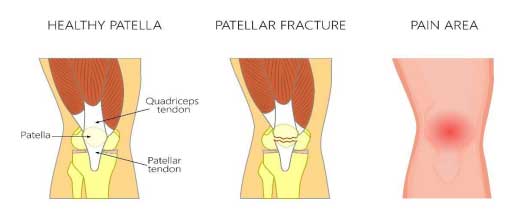In this section I want to talk about Knee Fracture (Patella Fracture). Where were you on the evening of June 4, 2015? I was watching Game 1 of the NBA Finals, Golden State Warriors versus the Cleveland Cavaliers. It was an exciting and intense game that went into overtime. With two minutes remaining in overtime, Kyrie Irving, the point guard for the Cleveland Cavaliers, was dribbling the ball. As he tried to make a hard cut to his right, he fell to the ground and immediately grabbed his left knee in pain. As the play continued, he eventually made his way onto his feet and hobbled first to his bench and then off the court to the locker room. His contorted face reflected his pain and frustration. The Golden State Warriors won the first game of the NBA Finals, but the main storyline was Kyrie Irving’s knee injury. The following afternoon, I learned that Kyrie fractured his left patella and needed season ending surgery. The Golden State Warriors went on to win the NBA Finals (4-2) in Game 6. To learn more about knee fractures continue to read the information below.
What is a knee fracture (Patella Fracture)?
● Embedded in a tendon, the kneecap slides and protects the joint.
● The ligaments attach the patella to both the quadriceps (thigh muscles) and the tibia (shin bone).
● A knee fracture is a break in the kneecap at the front of the knee joint.
● This is a severe injury and needs medical attention immediately.
Causes
● A direct or indirect trauma to the knee is the cause of the fracture, for example, a fall or motor vehicle accident.
Signs and Symptoms
● Pain around the kneecap or in the knee
● Bruising around the knee
● Swelling
● Inability to bend or straighten the knee or to hold the leg straight
● Inability to bear weight, stand, or walk
● Deformed appearance of the knee
● Bone protrusion from the skin or the knee
Treatment
● If someone you know or you have any of the symptoms listed above, please contact your primary care physician or go directly to your nearest urgent care facility.
● A physician will perform a knee assessment.
● A physician will order X-rays.
● Computerized Tomography (CT) or Magnetic Resonance Imaging (MRI) will be taken if necessary.
● NSAIDs (Ibuprofen or Naproxen) will be given for pain and inflammation.
● Analgesics, like Tylenol #3, may be given to reduce pain.
● An orthopedic consult to discuss any necessary surgeries will be completed.
● Rehab/Physical Therapy will be part of the treatment program.
o The treatment goals are to improve range of motion (ROM), build muscle strength, and decrease knee stiffness.
o Recovery times will vary and may take several months.

patella. Anatomy, front view of the human knee.
References
Aksanaku. (2022). [Illustration]. Vector illustration of a healthy knee joint and an unhealthy knee with displaced fracture of the patella. Anatomy, front view of the human knee. https://www.shutterstock.com/image-vector/vector-illustration-healthy-knee-joint-unhealthy-1336286213
Johns Hopkins Medicine. (2022). Kneecap Fractures (Patella Fractures). https://www.hopkinsmedicine.org/health/conditions-and-diseases/kneecap-fractures
Patel, K. H., Reddy, A., Eachempati, K., Muralidhar, S., & Jungele, A. (2018). A Patient with Osteoarthritis
Knee and Prior Patella Fracture: Single Stage Fixation and Total Knee Arthroplasty: A Case Report. Journal
of orthopaedic case reports, 8(1), 67–70. https://doi.org/10.13107/jocr.2250-0685.1004
Steele, M. (2020). Knee Fracture Management in the Emergency Department Medication. Medscape. https://emedicine.medscape.com/article/825572-medication#3
